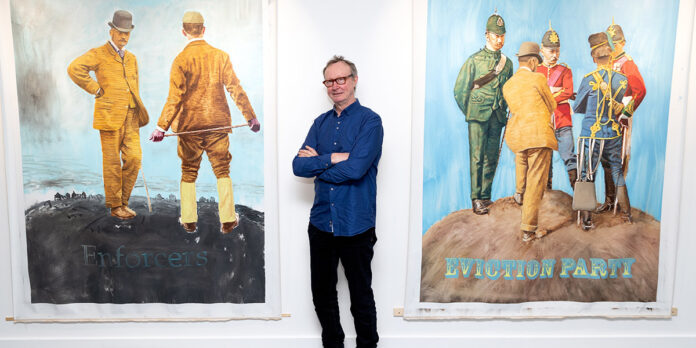Clare is a complicated county. A place of tradition and inspiration, of discipline and recklessness, of old habits and new beginnings.
Editors Anne Jones and Peadar King set out to explore the dichotomy that resides within the Banner in their book, ‘The Art of Place: People and Landscape of County Clare’. The book features personal accounts of 31 Clare artists, who were either born in Clare or moved to the county.
Later this week, this discussion will be brought to a live audience at the Armada Hotel in Spanish Point where two of the featured artists, Ennis painter Mick O’Dea and Miltown Malbay singer-songwriter, Tim Dennehy, will be in conversation with Peadar King.
“When we were thinking about that book, I was particularly conscious that a lot of the narrative that has come through [about Clare] over the last few decades has been written by people involved in the GAA or from parishes. If you look at those particular narratives, there is a commonality across all of them,” Mr King told The Clare Champion.
“They are really important accounts of contemporary life in County Clare which give acknowledgement and recognition to people’s lives in their local areas. They provide an important archive for future generations when people come to study life in the 1960s, 70s, 80s, 90s and into the current millennium.
“But, in terms of reading across them, what really strikes me is the unifying theme that runs through them that gives emphasis to society as this cohesive unit.
“These are very comforting narratives and these comforting narratives can conceal as much as they reveal. They conceal the fault lines that exist in all communities.
“We know that, we look back at various events from the Magdaline Laundries to other features of Irish society, that there were many fault lines.
“Anne Jones and I had multiple conversations about these kinds of issues and how we wanted these issues to be discussed and explored in the book. One of the thoughts that we had was the absence of artists voices in that broader narrative in Clare.
“Our hope was that engaging with artists, either born in Clare or currently living in Clare, would give us that diversity of experience and perspective, and would result in us getting a more multi-layered understanding of what it is like to live in Clare. I think we largely got that from the 31 different artists who contributed to this.”
The book, which is illustrated by a series of photographs by The Clare Champion’s John Kelly, aims to provoke conversation by offering different perspectives of County Clare.
“One of things that is really interesting in the anthology is that the people featured who came to live in Clare, largely found it a place of refuge. That was a really striking feature, it was a place where they could be, a place where they could breathe more easily,” said Mr King .
“Some of the accounts of people who moved are really striking. Clare is a place where they could feel comfortable, where they could feel at home, even though it wasn’t their home in a sense. They found an ease here.
“That was juxtaposed with some of the accounts from people who grew up in Clare and moved elsewhere. Many of those people found it quite a claustrophobic environment to grow up in, and found their schooling, in particular, to be limiting. They found the dominant societal norms to be very restrictive.
“Although this does not apply to Mick O’Dea’s contribution, rather his is a celebration of pub life, comic books and toy soldiers, and the internal beauty of Ennis Cathedral.
“But the overall story of the book is interesting in this way, as you have these very different accounts of the same place. That is the richness of the book, it provides that textured, diverse but highly personalised account of what it is like to live in Clare.”
While conceiving the book, it was also important for Anne Jones and Peadar King that the submissions reflected a personal, and not sanitised, account of life in Clare. Contributors were encouraged to write in the first person, and not to pull any punches.
“We set a couple of criteria for people when we asked them to write, one of the important criteria was that they would use ‘I’ language. This is not an objective, sociological analysis of what it was like, this is a person account and people did avail of that,” said Mr King.
“They talked very personally and sometimes very challengingly about their experience in Clare. I feel really proud of the fact that this book was written. Were not supposed to be proud of the work that we do but I am proud of this.
“I was struck by Mark O Halloran, the filmmaker from Ennis. I was talking to him around the time that he wrote a piece for the book and one of his first films was Adam and Paul, and he said to me that he was really proud of Adam and Paul. How refreshing is that?
“I think Anne [Jones] would say the same, but I am really proud of this piece of work. I am really proud that the people who took part did so with a great level of integrity. People were really particular [about their contributions], they were read and reread until they were happy.”
Ennis painter, Mick O’Dea, and Miltown Malbay singer-songwriter, Tim Dennehy, who both featured in the book, will be in conversation with Peadar King in Spanish Point this Thursday night.
“The idea is to bring some of the people who contributed to the book to smaller, intimate settings. They will read extracts from the book, sing a couple of songs,” said Mr King.
“Mick’s work is on display in the Armadas, and that will provide a backdrop to the evening, so people can engage with Tim, Mick and myself, and that is a way of localising the conversations that took place in the book.”
Andrew Hamilton is a journalist, investigative reporter and podcaster who has been working in the media in Ireland for the past 20 years. His areas of special interest include the environment, mental health and politics.


